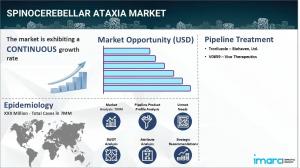Spinocerebellar Ataxia Market Size 2025-2035 Treatment, Trends, Epidemiology & Drug Pipeline
The report provides a detailed analysis of the current spinocerebellar ataxia marketed drugs and late-stage pipeline drugs, advancements in treatment.
BROOKLYN, NY, UNITED STATES, June 16, 2025 /EINPresswire.com/ -- According to the report by IMARC Group, he top 7 (US, EU4, UK, and Japan) spinocerebellar ataxia markets are expected to exhibit a CAGR of 7.22% during 2025-2035.Spinocerebellar ataxia (SCA) is a set of rare, hereditary disorders that gradually weaken coordination and balance by damaging the cerebellum. The market for SCA care now includes genetic tests, detailed imaging, routine physical and speech therapy, and a pipeline of new drugs aimed at altering the disease course. Momentum in 2025 stems from fresh research, advancing late-stage treatments, and a growing push to diagnose patients while symptoms are still mild.
Trends shaping the market in 2025
One clear driver is the quick rise of targeted medicines. Biohaven, for example, reports that its candidate troriluzole cuts progression by 50 to 70 percent over three years and may postpone key signs for as long as two years; the FDA has flagged it for speedy review, with a late-2025 decision possible. Approval would hand SCA patients the first therapy tailored to their genetics and reshape how clinicians plan care.
Precision approaches, such as gene editing, are gaining traction alongside these drugs. Scientists are fine-tuning CRISPR and other delivery systems to patch the specific mutations causing SCA, while refined MRIs and PET scans allow doctors to spot changes earlier and rule out look-alike conditions. Together, these trends promise faster starts to therapy and, researchers hope, longer windows of mobility for affected families.
Request a PDF Sample Report: https://www.imarcgroup.com/spinocerebellar-ataxia-market/requestsample
Key Market Drivers
Several factors are pushing the spin-off at accelerated rates. First, broadening genetic testing and alert healthcare teams now catch more spinocerebellar ataxia (SCA) cases. Second, national payers in leading markets are lifting reimbursement ceilings for rare brain disorders, so exams and drugs cost patients less. Third, fresh technologies-from AI-assisted scans to routine telemedicine-let clinics track symptoms and tailor therapy without demanding office visits.
Finance for rare-drug research is rising even faster. Venture funds, small biotechs, and public grant arms now commit large pools to SCA projects. Success stories such as troriluzole-lending both evidence and momentum-spark new trials and reassure stakeholders. Meanwhile, agencies embrace faster pathways for high-need files, promising sooner access once studies close.
Supportive-care services are also expanding quickly. Teams mixing physiotherapy, occupational training, and speech guidance now feature in most treatment plans as proven gains spread. Backed by investors and clinicians, specialized SCA clinics are launching, bundling genetic advice with coordinated, wrap-around care.
The report also provides a detailed analysis of the current spinocerebellar ataxia marketed drugs and late-stage pipeline drugs.
In-Market Drugs
Drug Overview
Mechanism of Action
Regulatory Status
Clinical Trial Results
Drug Uptake and Market Performance
Late-Stage Pipeline Drugs
Drug Overview
Mechanism of Action
Regulatory Status
Clinical Trial Results
Drug Uptake and Market Performance
Buy Spinocerebellar Ataxia Epidemiology Report - https://www.imarcgroup.com/checkout?id=10991&method=809
Competitive Landscape
The competitive landscape of the spinocerebellar ataxia market has been studied in the report with the detailed profiles of the key players operating in the market.
Biohaven, Ltd.
Vico Therapeutics
7 Major Countries Covered
United States
Germany
France
United Kingdom
Italy
Spain
Japan
IMARC Group Offers Other Reports:
Type 2 Diabetes Market Research
Hemophilia A Treatment Market
Erectile Dysfunction Drugs Market
Elena Anderson
IMARC Services Private Limited
+1 631-791-1145
email us here
Legal Disclaimer:
EIN Presswire provides this news content "as is" without warranty of any kind. We do not accept any responsibility or liability for the accuracy, content, images, videos, licenses, completeness, legality, or reliability of the information contained in this article. If you have any complaints or copyright issues related to this article, kindly contact the author above.
All Aboard! Thomas & Friends™ Returns to The Delaware River Railroad Excursions for an 80th Anniversary Celebration
Assurance maladie : un tiers de la population suisse envisage de quitter sa caisse en 2026
Krankenversicherung: Ein Drittel der Schweizer Bevölkerung erwägen, bis 2026 die Krankenkasse zu wechseln
Więcej ważnych informacji
 Jedynka Newserii
Jedynka Newserii

 Jedynka Newserii
Jedynka Newserii

Handel

1 października ruszy w Polsce system kaucyjny. Część sieci handlowych może nie zdążyć z przygotowaniami przed tym terminem
Producenci, sklepy i operatorzy systemu kaucyjnego mają niespełna dwa miesiące na finalizację przygotowań do jego startu. Wówczas na rynku pojawią się napoje w specjalnie oznakowanych opakowaniach, a jednostki handlu powinny być gotowe na ich odbieranie. Część z nich jest już do tego przygotowana, część ostrzega przed ewentualnymi opóźnieniami. Jednym z ważniejszych aspektów przygotowań na te dwa miesiące jest uregulowanie współpracy między operatorami, których będzie siedmiu, co oznacza de facto siedem różnych systemów kaucyjnych.
Ochrona środowiska
KE proponuje nowy cel klimatyczny. Według europosłów wydaje się niemożliwy do realizacji

Komisja Europejska zaproponowała zmianę unijnego prawa o klimacie, wskazując nowy cel klimatyczny na 2040 roku, czyli redukcję emisji gazów cieplarnianych o 90 proc. w porównaniu do 1990 rok. Jesienią odniosą się do tego kraje członkowskie i Parlament Europejski, ale już dziś słychać wiele negatywnych głosów. Zdaniem polskich europarlamentarzystów już dotychczas ustanowione cele nie zostaną osiągnięte, a europejska gospodarka i jej konkurencyjność ucierpi na dążeniu do ich realizacji względem m.in. Stanów Zjednoczonych czy Chin.
Handel
Amerykańskie indeksy mają za sobą kolejny wzrostowy miesiąc. Druga połowa roku na rynkach akcji może być nerwowa

Lipiec zazwyczaj jest pozytywnym miesiącem na rynkach akcji i tegoroczny nie był wyjątkiem. Amerykańskie indeksy zakończyły go na plusie, podobnie jak większość europejskich. Rynki Starego Kontynentu nie przyciągają jednak już kapitału z taką intensywnością jak w pierwszej części roku. Z drugiej strony wyceny za oceanem po kolejnych rekordach są już bardzo wysokie, a wpływ nowego porządku celnego narzuconego przez Donalda Trumpa – na razie trudny do przewidzenia. W najbliższym czasie na rynkach można się spodziewać jeszcze większej zmienności i nerwowości, ale dopóki spółki pokazują dobre wyniki, przesłanek do zmiany trendu na spadkowy nie ma.
Partner serwisu
Szkolenia

Akademia Newserii
Akademia Newserii to projekt, w ramach którego najlepsi polscy dziennikarze biznesowi, giełdowi oraz lifestylowi, a także szkoleniowcy z wieloletnim doświadczeniem dzielą się swoją wiedzą nt. pracy z mediami.



![Nestlé w Polsce podsumowuje wpływ na krajową gospodarkę. Firma wygenerowała 0,6 proc. polskiego PKB [DEPESZA]](https://www.newseria.pl/files/1097841585/fabryka-nesquik_1,w_85,r_png,_small.png)




.gif)

 |
| |
| |
|